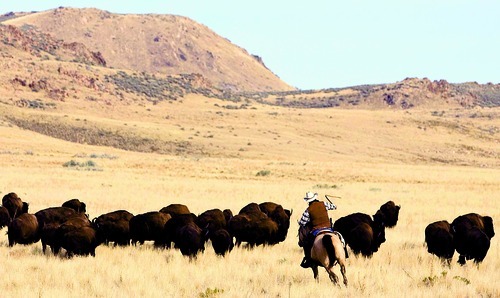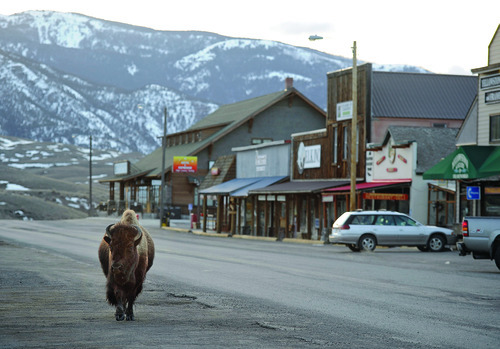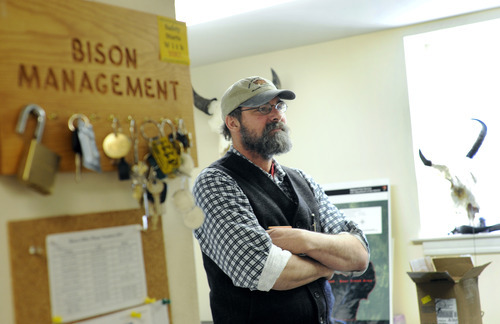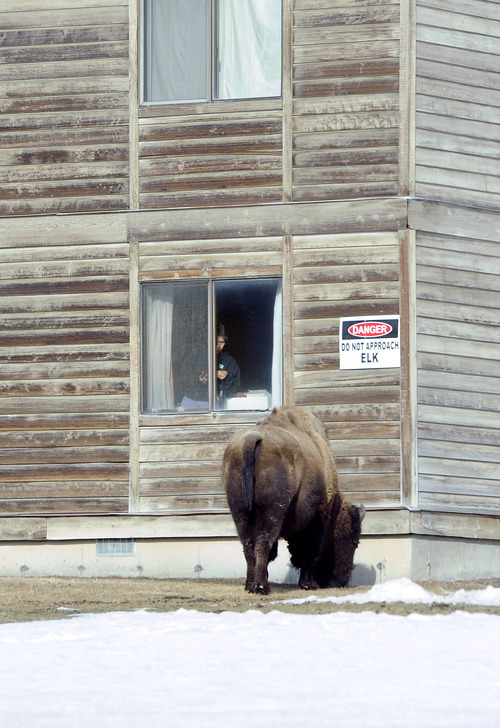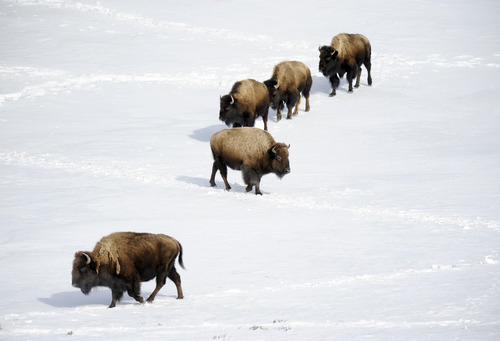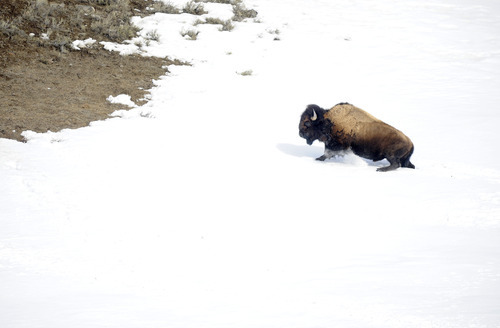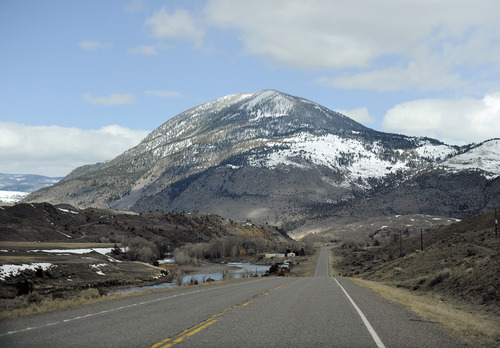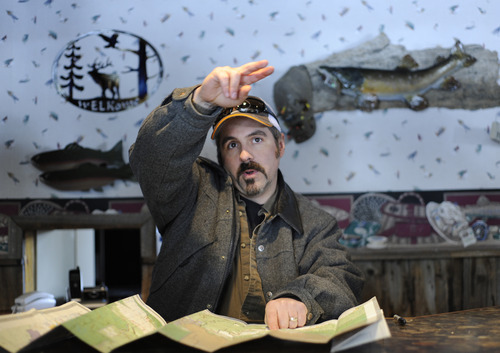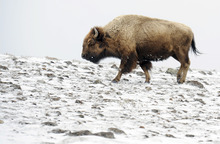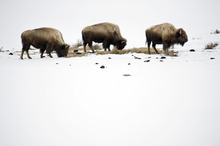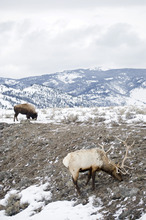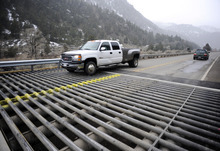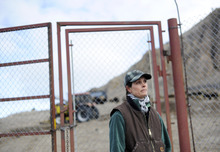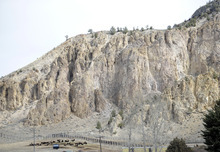This is an archived article that was published on sltrib.com in 2011, and information in the article may be outdated. It is provided only for personal research purposes and may not be reprinted.
Gardiner, Mont. • A new highway cattle guard and fence are paradoxically the surest signs of a historic breakthrough allowing Yellowstone bison to roam free north of the park.
A grate of steel pipe laid in place of asphalt to prevent the 1-ton beasts from hoofing beyond where the road squeezes through Yankee Jim Canyon, this barrier is just 15 miles north of Yellowstone's boundary. But that's about 15 miles beyond where Montana has ever, before this winter, let the park's most conspicuous inhabitants roam without horseback hazing, shooting, corralling and occasional slaughter to block them from infecting cattle with the calf-aborting bacterial disease brucellosis.
The state hasn't released its deal with federal wildlife managers, and even now hundreds of bison trapped in February are being restrained at the park boundary. Wildlife managers are collecting agency signatures for an agreement that would allow tested, disease-free bison to roam Gardiner Basin as far as the cattle guard in future winters. They plan to present it at a public meeting here Thursday. But even before that formality, bison leaving the park in recent weeks have enjoyed an unofficial free pass.
"It's a native species, for God's sake," said Montana Gov. Brian Schweitzer, a Democrat who counts himself a cattleman, explaining why he is softening the state's hard line and hoping to establish more wild bison herds on the plains despite opposition from the livestock industry. He called the bison, popularly nicknamed the American buffalo, a symbol of the West. "You cannot be more Montana than the buffalo."
Their new territory is a flat-bottomed, grassy bowl, largely brown in late winter because the craggy mountains of the Gallatin Range wring out much of the snow that might otherwise fall here. It's just one little valley — hardly enough space to make Yellowstone's nearly 4,000 bison truly free-roaming. After decades of zero tolerance beyond the park, though, it's enough to give wildlife lovers, hunters and the governor hope for a wider restoration.
"To say there's no more room in Montana for bison," Schweitzer said, "is ridiculous."
Yet there hasn't been room until now, and there still isn't much. Since the mid-1980s, Montana has shot or sent to slaughter nearly 7,000 bison — more than 1,000 per season in the harshest winters of 1997 and 2008 — and government agents have hazed many more back into the park. On Yellowstone's west side, where traditionally deeper snows have kept cattle off the range until well after the bison are back in the park, the state already tolerated some seasonal movement onto a peninsula near Hebgen Lake, where landowners welcome them.
Some bison leave Yellowstone for lower elevations every year, but only every few years is there enough snow to push hundreds past the boundary at Gardiner and into trouble. This was one of those winters.
—
Bison DMZ • Early snowpack levels were almost a third higher than normal. By February, park officials, acting according to an interagency agreement with the state and other agencies, had guided nearly 600 bison into a corral at the boundary and sent a few dozen more to a U.S. Department of Agriculture research pen north of town.
Those that tested positive for brucellosis exposure — about 40 percent this year, according to the National Park Service — appeared bound for Montana slaughterhouses that month until Schweitzer announced he wouldn't allow it. He said trucking infected bison across the state increased the possibility that magpies or other scavengers around slaughterhouses could pick up scraps infected with the bacteria and move it near cows.
So those animals remain in pens, awaiting a spring thaw that will attract them back to their usual range in the wild, sweeping grasslands of Yellowstone's Lamar Valley. In the meantime, the governor's new policy in recent weeks has allowed dozens more to rove north in small groups, down the Yellowstone River, and mill around Gardiner Basin's scattered homes and cabins in a suddenly demilitarized zone.
"If you leave [the bison] alone, they leave us alone," said Dorine Rate, a 74-year-old cowgirl whose family's 25 head of cattle make up one of just two small herds left in the basin.
The valley's declining cattle count, along with area ranchers' uniquely permissive attitude, is partly responsible for this evolving breakthrough. The wildlife managers, with help from advocacy groups including the Greater Yellowstone Coalition, previously paid $3.3 million to the valley's Church Universal and Triumphant, a new-age religious organization, to remove its 100 cows from its ranch-centered community. The church had stood in the way of bison range expansion for years, but Rate and her husband, Hank, 79, aren't about to complain if woolly crowned bovines keep lounging within sight of their riverfront home.
Left alone this spring, the Rates said, the bison avoid their cattle, which they vaccinate against brucellosis. The bison occasionally leap fences but never go through them unless provoked — as armed livestock agents provoked them in the bloody winter of 1997.
"They hadn't done a damn bit of damage," Hank Rate recalled of that year's bison before the killings started, "but [agents] started shooting them, and they took out every fence on the place." Just like the elk, foxes, wolves, bighorn sheep and bears, the bison are part of the natural surroundings the Rates bargained for when they moved here in the 1960s.
"It's a wildlife show," Dorine Rate added, "if people would just relax a bit."
—
Rift with ranchers • The Church Universal and Triumphant is concerned about personal safety, throughout the valley and around members' homes on its Royal Teton Ranch, church business manager Alan Shaw said.
When it took the money to remove its cattle, the church also agreed to allow passage across its ranch to a national forest meadow to the north. That experiment originally called for just 25 bison this winter. But after managers tried that early in the season, the state's newly tolerant attitude meant more bison ambled north from the park.
By late March, bison dung was scattered across a tree-lined grass berm that obscures the sect's chapel from a passing road.
Cattle ranching enjoys a strong position in Montana's culture and politics, though in this case, the lobby is at odds with the governor. The Montana Stockgrowers Association opposes any free bison movements outside the park until, according to Executive Vice President Errol Rice, wildlife managers get a handle on disease in the herd.
"This decision by the state ... I don't know," Rice said. "We have to make some more meaningful progress on this [brucellosis] issue before we move in this direction."
The ranch association supports a plan — which the National Park Service is considering — to vaccinate bison within the park using pellet-gun "biobullets." That plan is controversial because it would cost millions and offer little chance of eradicating the disease in a herd that interacts with elk that also are infected.
Rice rejects the idea of moving disease-free bison to new ranges in Montana because migratory elk carrying the disease could reinfect them. Montana lawmakers taking up the ranchers' cause during this winter's session have sought a ban on transplants, among other bills restricting bison. Schweitzer said those measures likely won't become law because "I've got a big ol' brand that says 'veto' on it."
The governor also criticizes the National Park Service for refusing to hunt or otherwise control disease-carrying animals within the park. The dispute could limit further flexibility by the state.
—
The bison's savior • Numerous environmental groups hope Gardiner Basin is just the start and that land managers could open more places without significant cattle overlap so fewer bison will be rounded up and treated like livestock.
"Wildlife are supposed to be free-roaming," said Mike Leahy, Rocky Mountain regional director for Defenders of Wildlife.
For several years, the Assiniboine and Sioux tribes 300 miles northeast of here at Fort Peck Indian Reservation have tried to obtain Yellowstone bison for cultural purposes and lean meat for diabetic members. The cattle industry is attempting to thwart that, tribal wildlife director Robbie Magnan said, but he hopes the governor brokers a deal.
The animals would come from a government quarantine pen that has held disease-free animals, and Magnan said they pose no threat to cattle.
"They've been tested more than any animal I know of," he said.
Yellowstone was the wildlife reservoir that effectively saved the species at the Lamar Buffalo Ranch after a record-low count of 23 in 1902. The herd had rebounded to the thousands when, in 1968, the park service took the hands-off approach that it still prefers within Yellowstone. At some point, park scientists say, infected cattle introduced brucellosis to the area.
Despite the disease's threat to gestation, most females give birth every year and the herd grows more than 5 percent annually, park bison biologist Rick Wallen said. He argues that wildlife managers can effectively separate bison from cattle during the infectious calving periods, but he accepts that, even with Montana's new policy, the park will likely always have to maintain a boundary corral for bison that test positive.
"I love having bison at my place," said Wallen, who lives north of Gardiner and has enjoyed the new visitors this winter and spring. "They fertilize the area and they leave."
Nonetheless, he says safety fears are legitimate — he advises lowering the 70 mph speed limit for Highway U.S. 89 — and he warns the herd could threaten cattle.
Bison backers have long noted that brucellosis transmission from bison to cattle has never been documented. Wallen believes that's only because managers don't allow the two to mix at critical times. Some Yellowstone-area cattle have recently contracted the disease, though elk are thought to be responsible.
"If we allowed bison to colonize the whole Paradise Valley," Wallen said, "I have no doubt that there would be a lot more brucellosis transmission to cattle."
—
Northern exposure • Before this year, the nagging threat carried regulatory, as well as biological, perils. Previously, the U.S. Department of Agriculture's Animal and Plant Health Inspection Service rules could have revoked an entire state's brucellosis-free status for outbreaks in one area, a prospect that would devastate exports. Now, forced by the Yellowstone arrangement to rethink that policy, the government allows for regional isolation of the disease without the statewide smear on producers.
"That's one of the changes this year that may have opened things up," said Becky Frey, an APHIS wildlife-disease specialist.
State Veterinarian Marty Zaluski said that, as long as a big share of the herd is infected, he considers the Yankee Jim Canyon cattle guard the bison's northern frontier. The barrier eases his mind about allowing bison past Gardiner, he said, but the Montana Department of Livestock will kill bison that spill over the hills on either side of the barrier and threaten cattle in Paradise Valley.
"That's just a nonstarter," he said. "I'd want to rethink the whole Gardiner Basin if they're expanding their range" beyond Yankee Jim Canyon.
Yet a broader expansion into state and national forest lands is what some bison advocates want. Among them are hunters who make an economic case for a free-range policy that blocks movement only at conflict points. In fact, Dome Mountain Ranch, just north of Yankee Jim Canyon, is an outfitter eager to welcome bison hunters.
"That's why I thought we lived here — the wildlife," ranch manager Jim Klyap said.
Hunters would shell out big money and fill hotels if they could hunt bison widely in the canyons north of the park, said Jim Wisman, a Bozeman, Mont., hunter and member of the Gallatin Wildlife Association. His group frowns on the existing state hunt (nearly 8,000 entered this year's lottery for 44 bison permits, and the state estimates that several tribes with treaty rights to the animals killed about 185). It concentrates the killing in a small area at the park boundary for an experience the governor calls "shooting a couch."
"They're native wildlife," Wisman said, "but we're treating them like vermin."
Migration map
In severe winters like this one, hundreds of bison seek relief from the deep snow. To see a map, visit
http://bit.ly/e2d3hi (pdf). —
Return of the bison
• Early managers of Yellowstone National Park estimated the herd at 1,000 in 1880.
• Only 23 were confirmed in 1902, when market hunters threatened extinction.
• The government established the Lamar Buffalo Ranch within Yellowstone in 1906 to restore bison.
• The herd numbered 1,500 by the 1950s. Park rangers sometimes shot bison to control numbers.
• Yellowstone officials adopted a hands-off, "natural regulation" approach in the late 1960s.
• Fearing brucellosis transmission to cattle, Montana offered a border hunt in the 1980s.
• Public outcry over the game warden-assisted killings led Montana to halt the hunt in 1991. Unassisted hunts resumed in 2005.
• Wildlife managers started corralling bison in winters when they migrated past Gardiner, Mont., and trucked them to slaughter.
• Slaughters eclipsed 1,000 in the winters of 1997 and 2007.
• The National Park Service counted 3,900 bison in the park last summer.
• Montana Gov. Brian Schweitzer halted a planned 2011 slaughter and granted disease-free bison access to Gardiner Basin.


